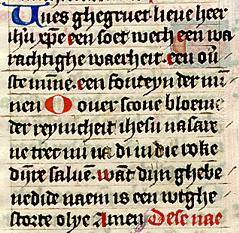Script Type : minuscule
Date : 12th to 15th centuries, this example from the later 15th century.
Location : Spread from France and the Low Countries across western Europe. This example is from the Netherlands.
Function : Book hand





























Distinctive letters : This Dutch language book of hours employs the same style of formal Gothic textura script as would have been employed for a formal Latin text. The letters are of standard textura form, rather broad and angular, with angular feet that finish in a long, fine oblique line. There are only a few conjoined letter combinations, and generally the script is not heavily compressed. The tops of ascenders of tall letters such as b, h, k and l are split into little triangular wedges. The letters are carefully formed, so that it is not difficult to differentiate n and v, for example. Where i appears next to other letters composed of minims, it is dotted with an exceedingly fine curved line. I guess you might just have to believe me on that one as it doesn't show up very well on screen.
The two forms of r are in use, but the simplified form appears not only after vowels, but also occasionally after consonants. Both the tall and the short and curly form of s are present.
The letter v is only differentiated from u when it appears at the beginning of a word. The letters i and j are not differentiated, except where j appears directly after i. I guess this derives from usage in Latin, where the second i in a doubled letter was elongated. This did not represent a consonant j, nor does it in Dutch, but that is the letter as used in modern spelling. Language does not evolve according to the rules of paleographers.
Being Dutch rather than Latin, k and w are present, but there are no examples of q or z to be found.
If your medieval Dutch is a bit shaky, pass the cursor slowly down the lines to get a quick transcript. To look at the whole page in more detail, proceed to the paleography exercises.
Paleography
exercises using Flash![]()
Requires at least the Flash 5 plugin
If you are looking at this page without frames, there is more information about medieval writing to be found by going to the home page (framed) or the site map (no frames).